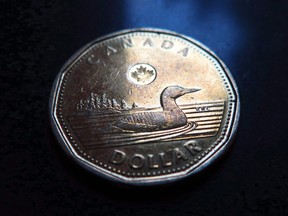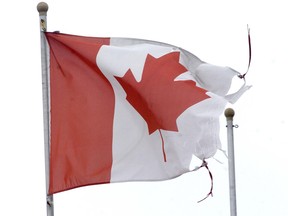Began to climb back up on reports that Mexico had been given a one-month tariff reprieve
Article content
The Canadian dollar dropped below 68 cents U.S. for the first time in more than two decades on Monday before rebounding by more than a cent, as uncertainty over a North American trade war sparked volatility across financial markets.
Article content
Article content
The loonie traded as low as 67.6 cents U.S. early in the day, it’s lowest level since 2003, but began to climb back up on reports that Mexico had been given a one-month tariff reprieve following a call between U.S. President Donald Trump and Mexican President Claudia Sheinbaum.
Advertisement 2
Article content
Karl Schamotta, chief market strategist at Corpay, said in a note that the Mexican peso, Canadian dollar, and euro were all “ripping higher” after the report.
Prime Minister Justin Trudeau is scheduled to speak with Trump later in the day.
Following the news, the Canadian dollar rose 1.4 per cent to 68.55 cents U.S. midday, still down around 0.3 per cent from Friday’s close.
Overall, the loonie has fallen 5.25 per cent since Trump was elected president.
As the trade rhetoric has escalated, signs have been building that the loonie could be in for significant ride down, economists and currency watchers have said.
Currency watchers at Canadian Imperial Bank of Commerce are calling for the Canadian dollar to fall as low as 67.5 cents U.S. possibly closer to the end of the week and to around 66 cents U.S. if the trade dispute lasts more than six months.
In another sign of the multiple challenges facing the loonie, the U.S. dollar index “screamed higher … challenging the two-year highs posted in mid-January,” economist David Rosenberg, founder of Rosenberg and Associates Inc., said in a Monday morning note.
Article content
Advertisement 3
Article content
The U.S. dollar index measures the international value of the greenback against a basket of other major currencies including the loonie.
“The (U.S.) dollar is stronger across the board,” Derek Holt, vice-president and head of capital markets economics at the Bank of Nova Scotia, said in a note on Monday. “Trump just doesn’t get it. U.S. tariffs on net reduce demand for foreign currencies through the harm to imports and raise safe haven appeal for the dollar.”
Holt said that tariffs will only increase the appeal of the U.S. dollar thereby widening the country’s trade deficit, which has been one of the president’s major concerns and apparent drivers for launching this trade war against his two main commercial partners.
“He’ll do more to strengthen the dollar, and on we keep going with the usual lagging effects,” Holt said.
CIBC’s currency team said in a note early Monday that “the tariff premium in USD/CAD now looks to be about four per cent,” although with bets rising for another Bank of Canada rate cut there could be a further 1.5 per cent risk.
Last week, Bank of Canada governor Tiff Macklem called U.S. tariffs a “major uncertainty” during a press conference after policymakers cut rates by 25 basis points to three per cent.
Advertisement 4
Article content
In the statement accompanying the decision, the central bank said: “If broad-based and significant tariffs were imposed, the resilience of Canada’s economy would be tested. We will be following developments closely and assessing the implications for economic activity, inflation and monetary policy in Canada.”
Recommended from Editorial
-

Loonie gets temporary reprieve as Trump holds on tariff threat
-

Weak loonie won’t stop Bank of Canada from cutting rates
Last week, the Fed held its policy rate in the range of 4.25 to 4.50 per cent as policymakers there cited a strong labour market, stickier inflation and uncertainty regarding the direction of the Trump administration.
Bonds reflected that dynamic. The price of Canadian bonds soared as traders increased bets that the Bank of Canada will be forced to cut interest rates at its next meeting in March to try and protect the Canadian economy. The price of the Canada two-year government bond rose 0.3 per cent while, the yield fell to 2.44 per cent, its lowest level since 2022.
• Email: gmvsuhanic@postmedia.com
Bookmark our website and support our journalism: Don’t miss the business news you need to know — add financialpost.com to your bookmarks and sign up for our newsletters here.
Article content
Canadian dollar dips below 68 cents U.S.
2025-02-03 18:40:37





